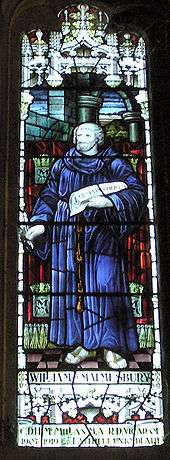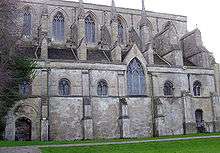William of Malmesbury

William of Malmesbury (Latin: Willelmus Malmesbiriensis; c. 1095 – c. 1143) was the foremost English historian of the 12th century. Hollister ranked him among the most talented English historians since Bede, "a gifted historical scholar and an omnivorous reader, impressively well versed in the literature of classical, patristic and earlier medieval times as well as in the writings of his own contemporaries. Indeed William may well have been the most learned man in twelfth-century Western Europe."[1]
William was born about 1095 or 1096[2] in Wiltshire. His father was Norman and his mother English.[3] He spent his whole life in England and his adult life as a monk at Malmesbury Abbey in Wiltshire, England.[4]
Biography
Though the education William received at Malmesbury Abbey included a smattering of logic and physics, moral philosophy and history were the subjects to which he devoted the most attention. The evidence shows that Malmesbury had first-hand knowledge of at least four hundred works by two hundred-odd authors.[5] During the course of his studies, he amassed a collection of medieval histories, which inspired in him the idea for a popular account of English history modelled on the Historia ecclesiastica gentis Anglorum (Ecclesiastical History of the English People) of Bede. William's obvious respect for Bede is apparent even within the preface of his Gesta Regum Anglorum,[6] where he professes his admiration for the man.
In fulfilment of this idea, William completed in 1125[7] his Gesta Regum Anglorum ("Deeds of the English Kings"), consciously patterned on Bede, which spanned from AD 449–1120. He later edited and expanded it up to the year 1127, releasing a revision dedicated to Robert, Earl of Gloucester. This "second edition" of the Gesta Regum, "disclosing in his second thoughts the mellowing of age",[8] is now considered one of the great histories of England.
William wrote of William the Conqueror in Historia Anglorum:
He was of just stature, extraordinary[9] corpulence, fierce countenance; his forehead was bare of hair; of such great strength of arm that it was often a matter of surprise, that no one was able to draw his bow, which himself could bend when his horse was in full gallop; he was majestic whether sitting or standing, although the protuberance of his belly deformed his royal person; of excellent health so that he was never confined with any dangerous disorder, except at the last; so given to the pleasures of the chase, that as I have before said, ejecting the inhabitants, he let a space of many miles grow desolate that, when at liberty from other avocations, he might there pursue his pleasures. His anxiety for money is the only thing on which he can deservedly be blamed. This he sought all opportunities of scraping together, he cared not how; he would say and do some things and indeed almost anything, unbecoming to such great majesty, where the hope of money allured him. I have here no excuse whatever to offer, unless it be, as one has said, that of necessity he must fear many, whom many fear.[10]

William's first edition of the book was followed by the Gesta Pontificum Anglorum (Deeds of the English Bishops) in 1125. For this vivid descriptive history of abbeys and bishoprics, dwelling upon the lives of the English prelates saints, notably the learned wonder-working Aldhelm, abbot of Malmesbury, William travelled widely in England. He stayed at Glastonbury Abbey for a time, composing On the Antiquity of the Glastonbury Church for his friend, the abbot Henry of Blois who was also the Bishop of Winchester. (Among the first works to mention SS Fagan and Deruvian, its present form is notably marred by anachronistic forgeries and additions.)
Around this time, William formed an acquaintance with Bishop Roger of Salisbury, who had a castle at Malmesbury. It is possible that this acquaintance, coupled with the positive reception of his Gesta Regum earned him the offered position of Abbot of Malmesbury Abbey in 1140. William, however, preferred his duties as librarian and scholar and declined the offer. His one public appearance was made at the council of Winchester in 1141, in which the clergy declared for the Empress Matilda.
Beginning about 1140, William continued his chronicles with the Historia Novella, or "modern history", a three-book chronicle that stretched from A.D. 1128–1142, including important accounts of The Anarchy of King Stephen's reign. This work breaks off in 1142, with an unfulfilled promise that it would be continued. Presumably William died before he could redeem his pledge. William also wrote a history of his abbey and several saints' lives.
Significance
William is considered by many, including John Milton, to be one of the best English historians of his time, and remains known for strong documentation and his clear, engaging writing style. A strong Latin stylist, he shows literary and historiographical instincts which are, for his time, remarkably sound. He is an authority of considerable value from 1066 onwards;[11] many telling anecdotes and shrewd judgments on persons and events can be gleaned from his pages. Some scholars criticise him for his atypical annalistic form, calling his chronology less than satisfactory and his arrangement of material careless. Much of William's work on Wulfstan, Bishop of Worcester, is thought to derive from a first-hand account from Coleman, a contemporary of Wulfstan. William merely translated the document from Old English into Latin. William's works are still considered invaluable and, despite these shortcomings, he remains one of the most celebrated English chroniclers of the twelfth century.
Works
- ed. Migne, Patrologia Latina vol. 179.
- William of Malmesbury: Gesta pontificum Anglorum (Deeds of the English Bishops), Vol. I, Edited and Translated by M. Winterbottom and R.M. Thomson, Oxford University Press, 2007. ISBN 0-19-820770-0
- William of Malmesbury: Gesta pontificum Anglorum (Deeds of the English Bishops), Vol. II: General Introduction and Commentary, by R. M. Thomson, Oxford University Press, 2007. ISBN 0-19-922661-X
- William of Malmesbury: Gesta regum Anglorum (Deeds of the English Kings), Vol. I, Edited and Translated by R. A. B. Mynors, R. M. Thomson and M. Winterbottom, Oxford University Press, 1998. ISBN 0-19-820678-X
- William of Malmesbury: Gesta regum Anglorum (Deeds of the English Kings), Vol. II: General Introduction and Commentary, by M. Winterbottom and R. M. Thomson, Oxford University Press, 2002, ISBN 0-19-820709-3
- William of Malmesbury: Historia Novella (The Contemporary History), Edited by Edmund King, Translated by K. R. Potter, Oxford University Press, 1999. ISBN 0-19-820192-3
- William of Malmesbury, Chronicle of the Kings of England, translated by Rev. John Sharpe, edited by J. A. Giles, London: George Bell and Sons, 1904.
- William of Malmesbury: The Deeds of the Bishops of England [Gesta Pontificum Anglorum], Translated by David Preest, Boydell Press, 2002. ISBN 0-85115-884-6
- William of Malmesbury (2011). Liber super explanationem Lamentationum Ieremiae prophetae. CCCM. 244. Michael Winterbottom, Rodney M. Thomson (eds.). Turnhout: Brepols. ISBN 2503540872. Translation: William of Malmesbury (2013). On Lamentations. Corpus Christianorum in Translation. 13. Michael Winterbottom (trans.). Turnhout: Brepols. ISBN 9782503548494.
See also
Notes
![]() This article incorporates text from a publication now in the public domain: Chisholm, Hugh, ed. (1911). "William of Malmesbury". Encyclopædia Britannica. 28 (11th ed.). Cambridge University Press.
This article incorporates text from a publication now in the public domain: Chisholm, Hugh, ed. (1911). "William of Malmesbury". Encyclopædia Britannica. 28 (11th ed.). Cambridge University Press.
- ↑ Hollister, Henry I, 2001: "Setting and sources", p3
- ↑ discusses the evidence for his age and thus his birth year
- ↑ Winterbottom, Michael (2010). "William of Malmesbury and the Normans". The Journal of Medieval Latin. 20: 70–77. doi:10.1484/J.JML.1.102101. Retrieved 30 August 2013.
- ↑ Rodney Thomson, William of Malmesbury, 1987 is the full-length study; see also Farmer, Hugh (1962). "William of Malmesbury's Life and Works". The Journal of Ecclesiastical History. 13 (1): 39–54. doi:10.1017/S0022046900065659.
- ↑ Thomson 1987:197–207.
- ↑ William (of Malmesbury) (1847). Chronicle of the Kings of England: From the earliest period to the reign of King Stephen. H. G. Bohn. pp. 175–. Retrieved 31 October 2012.
- ↑ Hollister 2001:4,
- ↑ Hollister 2001:4.
- ↑ William of Malmesbury, Chronicle of the Kings of England, ed. Giles, London 1847, p.308
- ↑ Quoted in James Westfall Thompson and Edgar Nathanael Johnson, An Introduction to Medieval Europe, 1300–1500 (1937) p. 440
- ↑ Momma, Haruko (2012). "Narrating the Battle of Hastings: Multilingual Britain and the Monolingualism of William of Malmesbury". In Ad Putter, Judith Jefferson (eds.). Multilingualism in Medieval Britain (c. 1066–1520). Medieval Texts and Cultures of Northern Europe. Turnhout: Brepols. pp. 225–239. doi:10.1484/M.TCNE-EB.1.100803.
Further reading
- Rodney M. Thomson, William of Malmesbury, Boydell & Brewer, 2003. ISBN 1-84383-030-2
- Kirsten A. Fenton, Gender, Nation and Conquest in the Works of William of Malmesbury (Woodbridge, Boydell, 2008) (Gender in the Middle Ages).
External links
| Wikiquote has quotations related to: William of Malmesbury |
- Latin Chroniclers from the Eleventh to the Thirteenth Centuries: William of Malmesbury from The Cambridge History of English and American Literature, Volume I, 1907–21.
- Full text of "William of Malmesbury's Chronicle of the kings of England. From the earliest period to the reign of King Stephen"
- Battle of Hastings, 1066, excerpts.
- Account of the Battle of Lincoln in 1141, excerpts.
- Historia Novella, excerpts.
-
 Texts on Wikisource:
Texts on Wikisource:
- William of Malmesbury 'On the Antiquity of Glastonbury' by Joseph Armitage Robinson
 "William of Malmesbury". Dictionary of National Biography. London: Smith, Elder & Co. 1885–1900.
"William of Malmesbury". Dictionary of National Biography. London: Smith, Elder & Co. 1885–1900. - Cousin, John William (1910). "
 William of Malmesbury". A Short Biographical Dictionary of English Literature. London: J. M. Dent & Sons. Wikisource
William of Malmesbury". A Short Biographical Dictionary of English Literature. London: J. M. Dent & Sons. Wikisource  Herbermann, Charles, ed. (1913). "William of Malmesbury". Catholic Encyclopedia. New York: Robert Appleton Company.
Herbermann, Charles, ed. (1913). "William of Malmesbury". Catholic Encyclopedia. New York: Robert Appleton Company.